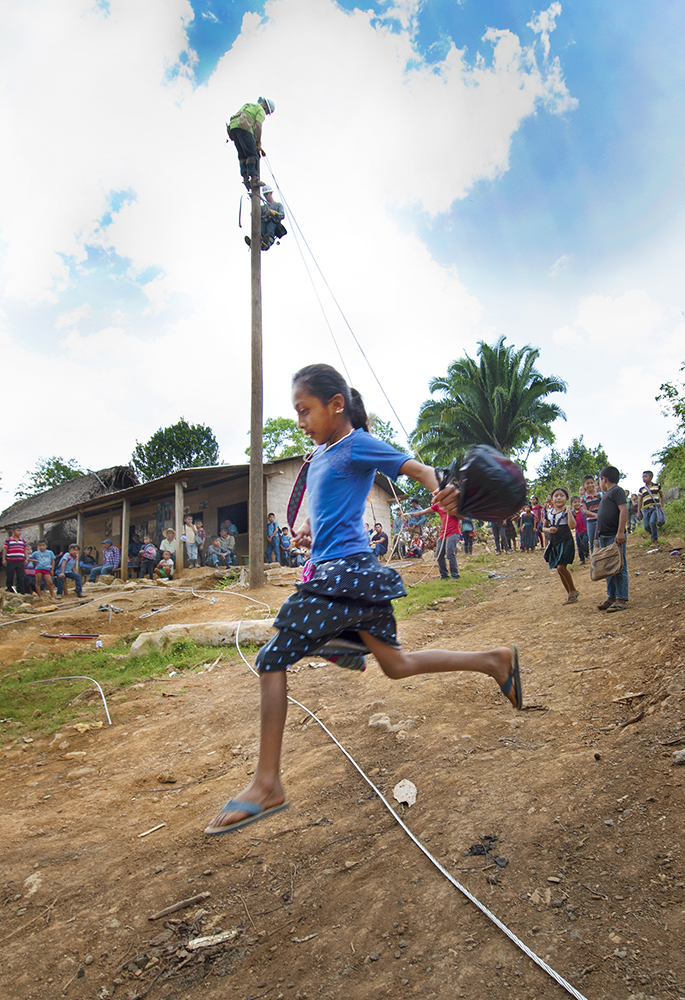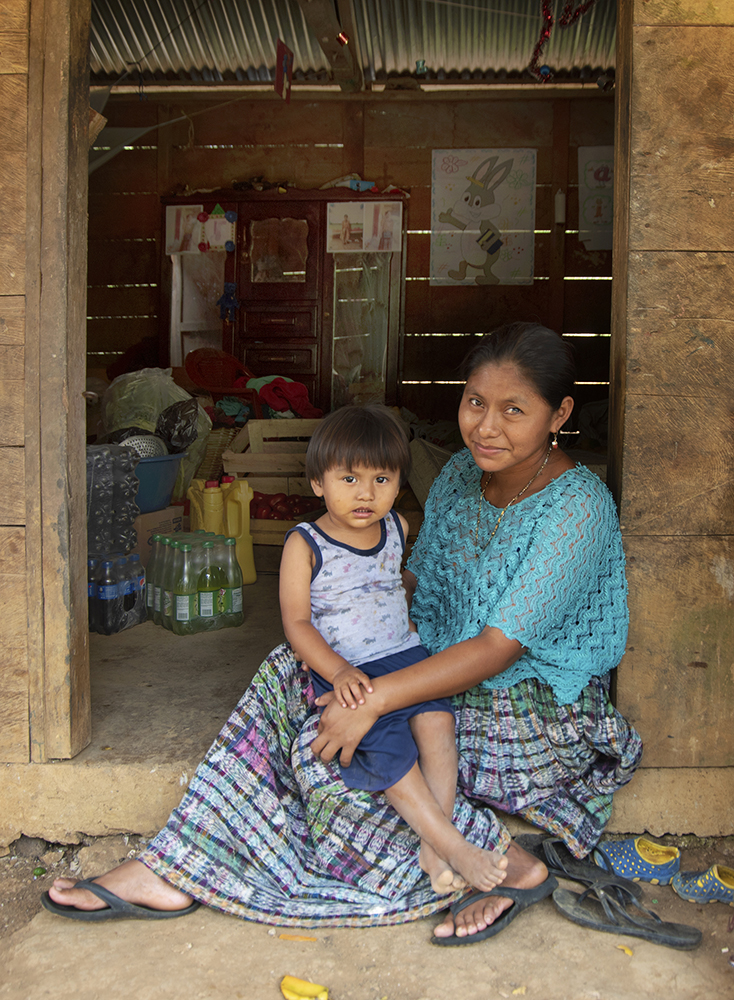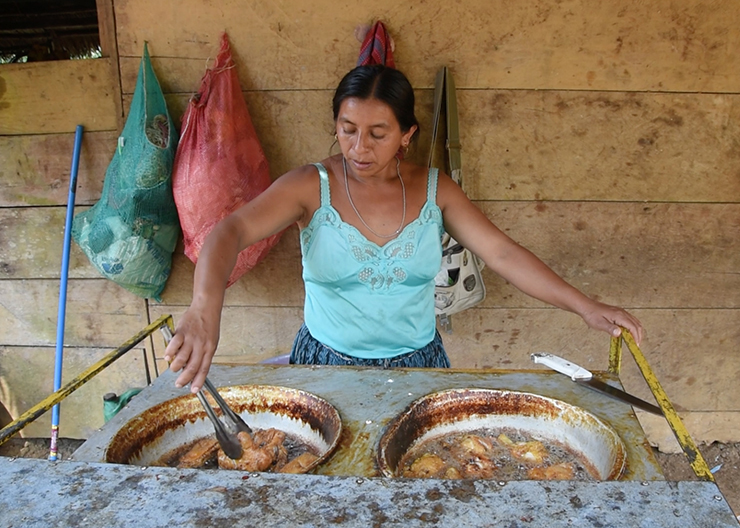Powering Up
Market owner says electricity means progress and opportunities for village

The day always started earlier for Macario Choc Cucul than for most in his little village of San Jacinto in east central Guatemala.
Every morning at daybreak, Macario left his wife, 18-year-old daughter, and 7-year-old son, and motored along the rutted gravel and rocky roads between San Jacinto and his brother’s home about a half hour away.
Macario and his family own and operate what might be considered the largest convenience store in San Jacinto. Their store, which doubles as their home, sits right by the sign that welcomes visitors along the only gravel road through town. And it’s fortuitously situated at the “T” where a dirt and rocky road takes off up over a steep hill to the village school and other homes and a church farther up. It’s a popular gathering place for the local men to visit while having a cold soda. And it’s the last or first stopping off spot for kids walking to and from school for snacks — like chips, ice cream, or a squeeze tube of frozen flavored custard or ice.
Until electricity came to the village via Project Indiana’s 2019 undertaking, just making sure he could keep the cold products cold throughout the steamy afternoons was a big part of Macario’s early morning chores.
Macario already owned two refrigerator/freezer units. But he had to keep them at his brother’s home which is in one of the 12 small towns electrified in the Las Conchas area a decade ago. So, at his brother’s home, Macario, 40, would have to load up coolers with ice, cold drinks and other cold snacks, and then drive the half hour back to his store to sell the items during the day.
Having electricity at the store will mean moving the refrigeration units on site … and so much more.
“Electricity means progress,” he said through an interpreter in the Mayan language of Q’eqchi spoken throughout the region. “It means better opportunities in the community.
“In school,” he said, “kids will have opportunities to learn about computers, have a laboratory, TV, and videos.” And he noted lights in the school will allow longer study times into the later afternoons and perhaps, at some point, air conditioning.

Macario said his family came to the Las Conchas area from Cobán, the capital of the department of Alta Verapaz, when he was in his teens. They had electricity there, he said, but he couldn’t really recall how the move affected him and his family at first. That was a quarter century ago. His father, a farmer, bought land in the Chahal municipality when larger parcels of land could no longer be purchased in Cobán. Macario’s siblings divided the land among themselves and, 18 years ago, he opened his market in San Jacinto.
Alongside the front of a thatch-roofed part of the store, stacks of crates await his next trip into the city of Chahal. There, he fills them with produce he purchases at the open market and resells in San Jacinto. His market also sells beef and chicken. Chocolate-covered bananas are also popular with youngsters, he said.
While many in San Jacinto said refrigerators would be high on their list of first appliances once electricity arrived, Macario and his family were considering a computer and a TV for the family. He said he’d like to see San Jacinto eventually build a public library, too, to make higher-tech electronics available to everyone.
With Guatemala being the number one country from which illegal immigration to the United States originates, Macario said development like electricity is key to keeping folks grounded to their home. “Some people will go away from here without electricity for better opportunities,” he said. “Now, with electricity, they will stay.”
And for electricity, he is grateful on this particular late March afternoon in 2019 to Project Indiana and its dedicated lineworkers who are building power lines throughout the town. “God will bless you,” he said for their efforts.
Better diets in the refrigerator light
It’s the middle of a hot sunny afternoon, and San Jacinto is quiet — except for the persistent crowing of a time-warped rooster across the road from the green concrete-block Catholic church, just down the hill from Macario’s place. Project Indiana lineworkers have fanned-out from the center gathering point at the church and are off building tap lines in the karst hilly landscape above the town and in both directions along the main road.
In the shade of the front porch of their home and store, Macario’s wife, Petrona, fires up propane burners beneath two deep vats filled with cooking oil. Soon, she drops breaded chicken into the boiling oil. The frying sounds like hard rain when it falls on the tin roofs overhead. Using metal tongs, she reaches into the vats, moves the pieces around and talks to passersby. She occasionally lifts a piece out for a looksee, and drops it back in.

Finally, a drumstick is ready. She grips it tightly with the tongs and bangs the metal utensil against the side of the vat to shake excess oil from the chicken and sets it on a plate. She finds another piece and places it beside the first piece. Then, she tops them with a variety of sauces from squeeze bottles and sets the plate out to entice customers to purchase the chicken as she continues cooking. Once all the pieces are fried, she moves them from the oil to a pot and shuts off the propane tank.
While electricity may not replace the propane burners anytime soon, certainly the refrigeration units on site — and in the homes of residents in San Jacinto — will aid Macario and Petrona’s efforts to sell meats and other products, and they’ll be able to offer more variety.
Just as the refrigeration that came with electrification made a huge impact on improving the diets and, along with that, the health of rural Americans in the 1930s and 1940s, it’s expected to do the same with the villagers of San Jacinto.
And, along with improved diets, there’s a simpler pleasure folks there may soon discover with electricity and appliances: The joy of treating themselves to a midnight snack of leftover fried chicken — snatched cold, straight from a plate by the refrigerator light.
